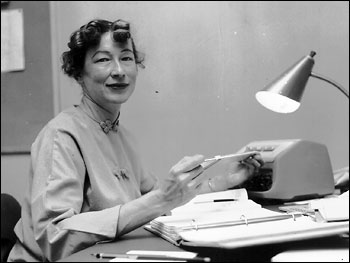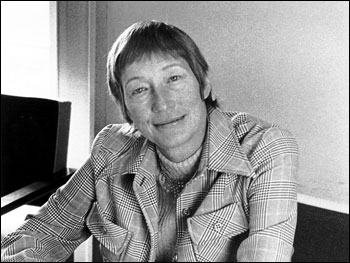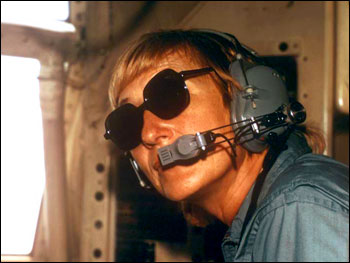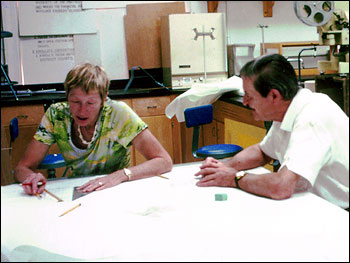

The Weather Modification Roller CoasterIn 1960, Simpson was a full Professor at the University of California Los Angeles, where she designed and taught graduate classes, and wrote two books. She also “computerized” her cloud model and began looking for ways to test it. Simpson realized that cloud seeding experiments would be a good way to test how well the model she had developed described how clouds really behaved. Since the late 1940s, scientists had known that silver iodide introduced into a cloud with super-cooled water droplets led to the formation of ice crystals. But by the 1960s, no one had figured out exactly how clouds behaved after being seeded. Simpson’s model predicted that the large amount of latent heat released as the cloud’s water droplets changed to ice would, under certain conditions, cause a cloud to grow much taller and to more than double in size compared to an unseeded cloud. 
Joanne Simpson became a full professor at UCLA in 1961. While there she developed the first computer cloud model. (Photograph courtesy Joanne Simpson and the Schlesinger Library) Simpson got her chance to test this hypothesis in 1963 by “bootlegging” aircraft time during Project Stormfury, a weather modification experiment started in 1961 by Simpson’s future husband, Bob Simpson. She flew up above clouds and ejected flares from a chute under the airplane. The flares ignited and created silver iodide smoke, which dispersed silver iodide fairly evenly over clouds. The clouds behaved just as her cloud model predicted. “We wrote an article and a furor broke loose,” said Simpson. “I was totally unaware of the level of emotion and hostility that was directed against anything that had to do with cloud seeding.” Many in and outside of the scientific community were skeptical of weather modification. The main fear was that meteorology would get a bad name by the promises of charlatans. In 1964, Simpson left UCLA to take a position with the National Weather Bureau (which later became the National Oceanic and Atmospheric Administration). In 1965 she married Bob Simpson, who headed the Weather Bureau’s Severe Storms Program. The Simpsons moved to Miami, where Bob became the Director of the National Hurricane Center and Simpson headed the Experimental Meteorology Laboratory. She somewhat reluctantly agreed to take charge of Project Stormfury. Stormfury’s primary objective was to test a hypothesis that a hurricane’s maximum winds could be weakened by about 10 percent if the most active area of the eyewall could be massively seeded. The project was based on a reasonable hypothesis that required careful testing, but it became bitterly controversial, with insults in speech and print that were often assaults on the personal integrity of the scientists involved in Stormfury. Permission for seeding was restricted to a very small area in the western Atlantic. Between 1964-68, Stormfury deployed its aircraft, only to find that the sole suitable hurricane moved out of the permitted seeding area. Simpson decided she had ridden long enough on the weather modification roller coaster, and she passed the Stormfury Directorship on to a another good hurricane expert. Stormfury eventually fizzled in the 1970s after the low-flying aircraft in use at that time failed to find the kind of super-cooled clouds in which seeding was known to be effective. 
From 1964 to 1974 Simpson worked for the National Weather Bureau (later NOAA). While there she was the head of the Experimental Meteorology Laboratory. In 1972 she was awarded the Department of Commerce Gold Medal. (Photograph courtesy Joanne Simpson and the Schlesinger Library) Simpson decided to concentrate on cloud seeding experiments with an emphasis on the scientific processes involved, rather than on how they might be applied to weather modification. Simpson developed a double-blind experiment that convinced the science community that her cloud seeding hypothesis was correct. Simpson had tried to leave weather modification behind, but a young co-worker, Bill Woodley, found that the seeded clouds in Simpson’s experiment rained about twice as much as the controls. NOAA management got on the weather modification wagon again. They wanted the Experimental Meteorology Laboratory to show that the rainfall over a large area in south Florida could be increased by seeding. This was the beginning of a project called FACE (the Florida Area Cumulus Experiment). 
In 1973 Joanne Simpson lead the Florida Area Cumulus Experiment (FACE)—a NOAA program to enhance rainfall with cloud seeding. She is shown here aboard a NOAA Research Flight Facility C-130. (Photograph courtesy Fritz Hoelzl, NOAA) Early results looked favorable for area-wide rainfall increase. But scientists involved estimated that to detect just a 10-15 per cent rainfall increase they would need at least 600 cloud seeding test cases. NOAA management agreed to fund no more than 100. With so few cases, sharp scientists would mistrust the results, even if FACE seemed successful. Confronted with the agency’s militaristic, “no-argument” management style of the time, Simpson realized that she had to leave. Ultimately, FACE failed to demonstrate that cloud seeding could increase rainfall, effectively killing weather modification research in the United States. In 1974, Simpson left NOAA and became an Endowed Chair Professor in the Environmental Science Department at the University of Virginia, but even after her already substantial accomplishments, the mostly-male faculty did not regard her as a real professor simply because she was a woman. In fact, it became clear over the years that women faculty were held in such low regard there that it was nearly impossible to get a secretary! 
After leaving NOAA Simpson moved to the University of Virginia. Despite her record of ground-breaking science and leadership, she was often treated poorly by the male-dominated institution. In this photograph she studies data from the Global Atmospheric Research Program Atlantic Tropical Experiment with Claude Ronne. (Photograph courtesy Joanne Simpson and the Schlesinger Library) Luckily Simpson had been in touch with Dave Atlas, who at the time was putting together a new Laboratory for Atmospheres at NASA’s Goddard Space Flight Center. “He’d been going at it for about a year or so, and I asked him if he had any jobs left. He said, ’The Severe Storms Branch needs leadership, please come tomorrow morning.’” A one-year leave from the University extended into two, and in the end Simpson decided that Goddard was a far more favorable environment in which to work. Simpson counts the choice as the best career decision she ever made. next: The NASA Years
|
| ||